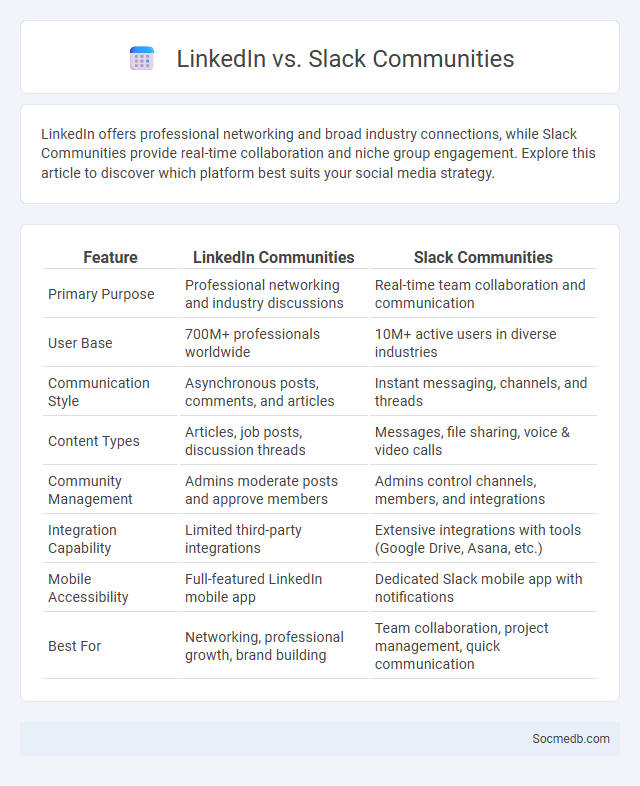
Photo illustration: LinkedIn vs Slack Communities
LinkedIn offers professional networking and broad industry connections, while Slack Communities provide real-time collaboration and niche group engagement. Explore this article to discover which platform best suits your social media strategy.
Table of Comparison
| Feature | LinkedIn Communities | Slack Communities |
|---|---|---|
| Primary Purpose | Professional networking and industry discussions | Real-time team collaboration and communication |
| User Base | 700M+ professionals worldwide | 10M+ active users in diverse industries |
| Communication Style | Asynchronous posts, comments, and articles | Instant messaging, channels, and threads |
| Content Types | Articles, job posts, discussion threads | Messages, file sharing, voice & video calls |
| Community Management | Admins moderate posts and approve members | Admins control channels, members, and integrations |
| Integration Capability | Limited third-party integrations | Extensive integrations with tools (Google Drive, Asana, etc.) |
| Mobile Accessibility | Full-featured LinkedIn mobile app | Dedicated Slack mobile app with notifications |
| Best For | Networking, professional growth, brand building | Team collaboration, project management, quick communication |
Overview of Online Professional Communities
Online professional communities are digital platforms where industry experts, entrepreneurs, and job seekers connect to share knowledge, network, and collaborate on projects. These communities, often found on LinkedIn, Slack, and specialized forums, facilitate peer-to-peer learning, mentorship, and career development through targeted discussions and resource sharing. Active participation in online professional communities enhances visibility, fosters partnerships, and accelerates career growth by tapping into collective expertise and industry trends.
What is LinkedIn: Key Features and Benefits
LinkedIn is a professional networking platform designed to connect businesses and professionals worldwide, offering features such as profile building, job searching, and industry news updates. Key features include LinkedIn Learning for skill development, advanced search filters for targeted networking, and endorsement systems to validate professional skills. Benefits encompass enhanced career opportunities, increased brand visibility, and engagement with a global community of industry experts.
Slack Communities: Functions and Capabilities
Slack Communities enhance social media interaction by offering organized channels for real-time messaging, file sharing, and collaborative project management. These communities support integrations with various tools like Google Drive, Trello, and Zoom, streamlining communication and workflow within teams. Advanced search functions and customizable notifications improve user engagement and ensure that important information is easily accessible.
Niche Communities: Definition and Importance
Niche communities are specialized social media groups centered around specific interests, industries, or hobbies, fostering deeper engagement and targeted interactions. These communities enable You to connect with like-minded individuals, share relevant content, and gain insights tailored to Your unique preferences. Leveraging niche communities on platforms like Reddit, LinkedIn groups, or specialized forums enhances brand loyalty and drives meaningful conversations within highly focused audiences.
Networking Opportunities: LinkedIn vs Slack vs Niche
LinkedIn offers extensive networking opportunities with millions of professionals, enabling You to connect, recruit, and explore career advancements. Slack provides real-time communication within focused groups, ideal for collaboration and immediate interaction among industry peers. Niche platforms specialize in targeted communities, facilitating deeper connections and industry-specific networking tailored to Your professional interests.
Engagement and Interaction Levels Compared
Social media platforms vary significantly in engagement and interaction levels, with visual-centric sites like Instagram and TikTok generating higher user interactions through likes, comments, and shares. Facebook still ranks high in maintaining community discussions, but Twitter's real-time conversations foster rapid information exchange and engagement spikes around trending topics. To optimize your social media strategy, focus on platforms where your audience's interaction behavior aligns best with your content style and engagement goals.
Content Sharing and Resource Accessibility
Content sharing on social media platforms enables your messages, images, and videos to reach a global audience instantly, increasing engagement and brand visibility. These platforms offer seamless resource accessibility, allowing you to upload, store, and distribute multimedia content efficiently across multiple channels. Advanced algorithms optimize content delivery to target audiences, enhancing the impact and reach of your shared resources.
Privacy, Security, and Moderation Differences
Social media platforms vary significantly in their approaches to privacy, with some offering end-to-end encryption and strict user controls, while others collect extensive personal data for targeted advertising. Security measures differ as well, ranging from robust multi-factor authentication and AI-driven threat detection to platforms with minimal protection prone to breaches. Moderation strategies are diverse, including AI-powered content filtering, human review teams, and community reporting systems, reflecting each platform's balance between free expression and preventing harmful content.
Choosing the Right Community for Your Goals
Selecting a social media community aligned with your goals requires analyzing platform demographics, engagement rates, and content formats. Platforms like LinkedIn offer professional networking opportunities ideal for B2B marketing, while Instagram excels in visual storytelling suited for lifestyle brands. Understanding your target audience's preferences ensures effective communication and maximizes return on investment in social media campaigns.
Future Trends in Professional Online Communities
Future trends in professional online communities emphasize increased integration of AI-driven networking tools that personalize connection suggestions and content relevance based on your industry and career goals. Virtual and augmented reality platforms are set to enhance immersive collaboration, enabling more dynamic interactions and realistic meeting environments. These advancements will transform the way professionals engage, learn, and grow within their digital communities.
 socmedb.com
socmedb.com